Osteochondrosis is the most common cause of back pain.Every person aged 40 will find damage to the intervertebral discs that develop the disease, and by the age of 50, 70% of the population is already surprising.At the same time, osteochondrosis is increasing today among young people and even teenagers.Disc hernia, radiation stones, brain supply disorders - all of which are complications of osteochondrosis, threatening disability, and often lead to disability.

Currently, effective treatments not only allow eliminating symptoms, but also help restore areas of vertebrae destruction, which are hardly in traditional medicine.Therefore, understand what factors can lead to disk destruction and why their lifestyle needs to change to stop the development of osteochondrosis.and what measures should be taken to deal with existing changes and initiate the recovery process in the spine.
What is osteochondrosis?How does the disease progress?
Osteochondrosis is a disease in which the destruction process of spinal motion fragments begins to prevail in the recovery process, which is manifested as back pain, limitations of fluidity, etc.During the development of this disease, vertebral hernia, radioactive disease (radiculopalpathy) can be formed.
Intervertebral discs (hereinafter referred to as "disks") are elastic fabric rings whose fibers are woven into overlying vertebrae and underlying vertebrae.Due to its special structure, the intervertebral disc protects each vertebrae from damage and ensures mobility of the entire spine (Tilments, Twisting).
In the center of the disc, is a pulp core, similar to a rubber pillow filled with liquid.In adults, it consists of 70% water and carbohydrates that can bind and impart water.When loading in the corresponding section of the spine, the core gives water and flattening, and the effect is terminated after the previous form.This shocking absorption pillow allows the spinal spring and extinguishes up to 80% of the spinal impact load.
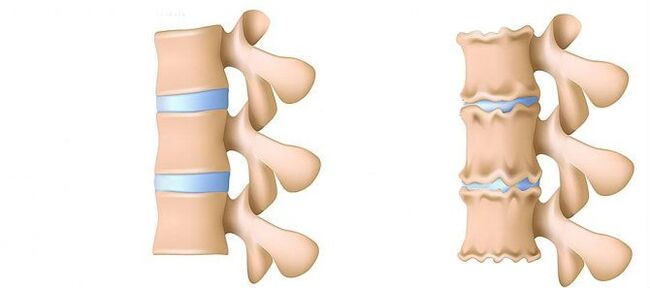
Degenerative nutritional processes most often begin with deterioration in shock absorption function of the intervertebral disc.
- Blood supply deteriorates to the intervertebral disc.In adults, food for the disc is performed by diffusion: only blood is delivered to the vertebrae, and has been “infiltrated” onto the disc through them.In the best way, the disk powers the pump in a dynamic load (e.g. walking) because of the principle of the pump (flow of fluid after compression, nutrients and oxygen flow when load is removed).Therefore, nutrition of the intervertebral disc is difficult, especially in the conditions of a sedentary lifestyle (sexual dynamics).
- Changes in the pulp cervix.As the blood supply deteriorates, the supply of water, sugar and amino acids is disturbed.Therefore, the production of carbohydrates connecting water is affected.The core is dehydrated, and its structure deteriorates from a gel-like structure to fibers, springs and extinguishing lenses.This increases the load on the annulus and vertebrae, which are more likely to be blocked and injured.
- Changes in the annulus of intervertebral disc.Due to flattening of the pulp pulpos, the increased load is located on the fiber disk ring.In the event of insufficient blood supply, the fibrous annulus loses strength.Instability in the spine occurs, which can lead to the formation of vertebrae hernia, the displacement of vertebrae, and damage to the spinal cord or nerve roots.
- Disk herniation.The formation of vertebral hernia.As the fibers of the annulus weaken, the pulp pulposus begins to protrude, for example, towards the spinal canal (disc herniation).Such a stunning person can further lead to the rupture of the fibrous annulus and the formation of hernia.Read more about the process of disc hernia formation in another article: “Effective treatment of disc hernia at home”.
- Spondylosis - Destruction of vertebrae joints (spine periosteum), growth of bone plants and bone chondria of ligaments.With the formation of intervertebral disc hernia, damage to vertebrae joints, destructive changes in vertebrae (cartilage) and ligaments in osteochondria.

Because the impact function of the intervertebral disc is not performed, the vertebrae and minor vertebrae are constantly injured.
The instability of the spine is also the cause of damage to the cartilage of the vertebrae and joint process systems.As a result, bone tissue grows and bone plants appear(From Greek: Bone - Bone, Plant - Plant)- Bone growth.The emergence of bone plants is often called spike formation or salt deposition.
- Bone plants continuously stimulate ligaments of vertebrae fragments, which gradually lead to ossification and limit movement of the affected spine.
- Bone plants may also damage nearby soft tissues, and the result is the accumulation of dead cells in dead cells, which will react with inflammation (edema).
- Bone plants on the surface of the vertebrae damage the fibers of the annulus towards the disc, thus accelerating the formation of hernia.The bone plants face the spinal canal, enhancing the compression of the spinal cord, blood vessels, and nerve roots.
- The growth of bone plants can lead to the enclosure of adjacent vertebrae and complete loss of vertebrae segments.
Symptoms and signs
Symptoms and Signs of Osteochondrosis - Back Pain!Initially, post-pain may occur due to over-treatment of the back muscles, which attempt to over-mov the vertebrae (stage 3), so the muscle protects the spinal cord located in the vertebrae column.The spinal cord is the central part of the nervous system, so the body tries to prevent its damage (squeezing, stimulation).Subsequently, the cause of the pain may already be the vertebrae of the vertebrae, even if it is small in size.When a hernia occurs, a person usually experiences severe pain (this is called the cervix or lumbar lad).

Due to back pain, a person involuntarily tries to take a position where the pain intensity is reduced - SO forced pose.Meanwhile, the spine is in a non-violent position, which can reduce the depreciation capacity of the disk.This increases the risk of further damage.
As joint invasion progresses, ossification of the vertebrae, joint surfaces and ligaments develops, the patient's spine begins to lose mobility.Partially, then completely limit the movement of the affected spine.
Complications of spinal osteochondrosis
Osteochondrosis complications in the spine occur in several stages.Their performance depends on the department where the destructive process occurs.
- Disogenous radiant stone (radiation disease), where the hernia process squeezes the nerve root (a bunch of nerve fibers that extend from the spinal cord and then divide into nerves until one or another area of the body).Pain is caused by the mechanical effect of hernia on the spine and the addition of inflammation (edema).
- Vascular Brown Syndrome, in which the container is squeezed to supply the roots of the spinal cord.It manifests as impaired movement in the hands (cervical osteochondrosis) or lower limbs (with lumbar spine), as well as loss of sensitivity.With this complication, the work of internal organs may be affected, and the affected nerves may develop, which may develop high blood pressure and memory deterioration.Sometimes, vascular erosion occurs suddenly and the movement of the affected area of the spine is dramatic - more commonly found in the lower back.Severe muscle pain and sudden weakness in the affected syndromeParalysis isotropic”.
- Violating the blood supply of the spinal cordCaused by compression of blood vessels feeding the spinal cord.The extreme degree of complication is ischemic spinal stroke.The consequences of this complication are impaired movement (paresis, paralysis) in the limbs, loss of sensitivity, deterioration in internal organ work to completely reject.In some cases, this can lead to death in the patient, for example, when renal function is severely suffering.
Symptoms of disc-derived inflammation depend on the spine:
| Place | Symptoms and signs |
|---|---|
| Cervical, cervical thymus radiant rock | Depending on the extent of damage to the neck, shoulders, forearms, fingers, pain and sensitivity.Muscle weakness in these departments can also be observed. Neurological pain in the occipital nerve is usually added, where severe pain in the head and back are noted.Arrhythmia may occur. |
| Lumbar spine size radiant rock | Pain in the lower back is manifested, and the lower back is often used in combination with sciatic nerve-Shia (Ishias, ishiradiculite).Weaknesses in the muscles of the foot can also develop, and thighs, calves and feet may occur. |
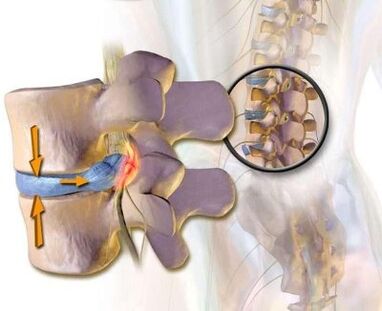
The subsequent displacement of the vertebrae or intervertebral disc that squeezes blood vessels and nerve roots may require emergency surgical intervention.
Causes of spinal osteocartilage degeneration
Osteocartilage degeneration is called a multifactorial disease - i.e., there may be many causes.Here we will pinpoint two key factors that gradually lead to the failure of the intervertebral disc and subsequent spinal changes:
- Deterioration of intervertebral disc under power conditions and cleaning of tissue.
- Excessive load on the spine leads to accumulation of dead cells in vertebral tissue.

The renewal of tissue in the disc depends on the adequacy of blood flow and the lymphatic flow directly to the disc, and neither the blood nor the lymphatic vessels are suitable (working in the body to clean the tissue).The food and cleaning of the disk are carried out indirectly, i.e. slow.This is why it happens not only quickly in this fieldNutrition deficiency and oxygen hungerAnd it's very fastDamage, dead cells accumulateand to formulate substances.Cleaning the fabric from the "slag" is necessary otherwise there will be no location for new functional cells, and the fabric will gradually lose its function (for example, the slurry of the disk will stop to the spring, depreciate, and will be flattened).
The tissue renewal of the intervertebral disc depends on the adequacy of blood flow and lymphatic flow.The speed and intensity of these processes are affected by the muscle micro-conductance of the back muscles during body stress.In this regard, one of the reasons for lack of feed and cleaning is low power when the back muscles are relaxed or in a static position.
As osteocartilage changes develop, blood supply in the spine, lymph and venous outflow may be due toMuscle spasm.The body sends signals to the muscles to keep the vertebrae in position relative to the affected area.The situation has been further exacerbated by excessive muscles for a long time.
For most people, it is obvious that the spine may suffer losses when lifting weights or being injured abnormally sharply, but the damage to the spine every day may be daily and less obvious in violation of the neuromuscular depreciation system.Under weak lymphatic flow conditions, constant microorganisms lead to the accumulation of dead cells, preventing the growth of functional cells, and further causing ossification of tissues.
Violation of neuromuscular depreciation is one of the main causes of osteocartilage degeneration
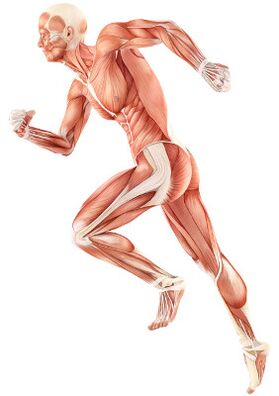
Violation of neuromuscular depreciation is one of the main causes of osteocartilage degeneration to reduce the load on the spine when walking, lifting, etc.The body has an overall neuromuscular depreciation system.This is ensured through the function of interacting with the body's nervous system and skeletal muscles to ensure smooth movement and extinguish the impact load on the bones, joints, and of course the spine.Therefore, most impact loads should be extinguished.Moreover, muscles in the legs and back are also involved in depreciation.If this does not occur (for example, uncomfortable high shoes do not allow the feet to work), the disc will be subjected to an unintended impact.The factors that cause non-divergence in the neuromuscular depreciation system are as follows:
- Violation of posture- Various types of spinal curves to prevent him from "spring", use of non-physiological furniture while working in the office, etc.
- Gait violation, run the technology (run correctly, transfer weight from toe to heel);
- Wearing high heels or without high heels has a negative impact on the depreciation ability of the feet.
- Too much load(engage in exercise, tired physical labor), traumatic joints and spine
- obesity- Excess weight can move the body's center of gravity, and fat tissue complicates the blood supply of muscles, and the behavior of nerve impulsiveness;
- Driving transport without depreciation (in the standing position you can bounce with your feet);
- For example, diseases of nervous system function are caused by frequent use of painkillers that negatively affect neuronal conductivity.
- Kidney interruptionDue to excessive formation of attenuation products in the body.This may be related to insufficient physical activity – a prerequisite for the work of the lymphatic system, which is responsible for cleaning the tissue of metabolites and dead cells, andLiver disease, chronic focus of inflammationETC.
Hypoemia
One of the causes of widespread osteochondrosis in recent decades has been the prevalence of a sedentary lifestyle.The muscles in the back and media in ordinary life are not involved enough and weakened quickly, and strong muscles are needed to keep the health of the spine free from overloading the tension of static tension, but are busy with dynamic work.The muscles in the back weaken the artery disease the fastest, which is full of the following consequences:
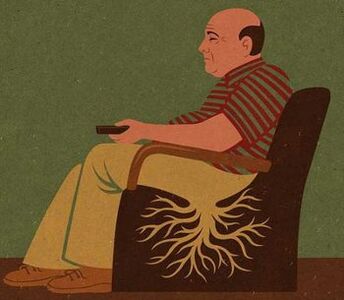
- Inadequate support of the spine during careless movements can lead to overload of the disc, displacement of the vertebrae and the occurrence of disc hernia.
- Deterioration of blood supply in the spine: Dynamic work of skeletal muscles is a prerequisite for blood flowing to any organ, including the spine.Destructive changes in the intervertebral disc progress due to insufficient manipulation of the back muscles - cells die from nutrients and oxygen deficiency.Dead cells accumulate and disturb recovery.
- The worsening of lymphatic flow and venous outflow leads to the accumulation of dead cells in the tissue.The work of skeletal muscle is particularly important for the work of the lymphatic system, because most of its blood vessels (e.g., lymphocyte capillaries) do not have muscle walls, and the “push” of lymph in the blood vessels depends on the work of skeletal muscle.
4 effective treatment principles
To eliminate symptoms, and to cope with the causes of osteochondrosis, spondylosis, radical inflammation and the development of ISHIA, the following tasks need to be addressed:
- Create opportunities to clean tissue from dead cells.This is a necessary condition for recovery to prevent further formation of bone plants and release space for tissue regeneration.To do this, restore/enhance lymphatic flow and venous outflow in the affected segment;
- Enhance blood supply to affected areas;
- Improves the tone of all muscles supporting the spine.This will allow:
- Create stimulus conditionsMy ownblood flow and lymphatic flow in the spine;
- Recover the operation of the neuromuscular depreciation system, which is necessary to support the spine enough to prevent new damage.
- Eliminate pain, as this will give you a chance:
- Remove muscle clips that block blood flow in the spine;
- Avoid forced poses.
Drug (medicine) treatment
Today, in the treatment of osteochondrosis and its complications, the following groups of drugs are used:
- Sclerotic Anti-inflammatory Drugs (NSAIDS)- In the form of a drug tablet or injection.These funds have the ability to reduce pain and reduce inflammatory activity.However, their effects won't last long - from a few hours to two to three days.So it has to take a long time - weeks, sometimes months.At the same time, these drugs have a negative impact on the mucosa of the gastrointestinal tract.Their long-term reception is full of gastritis, the development of ulcerative lesions.In addition, they may negatively affect the work of the kidneys, liver and contribute to the development of hypertension.And, at the same time, these funds don’t help clean up the disk from dead cells.Therefore, their use is just a way to relieve symptoms for a while, but it does not eliminate the main problem.
- ctepid (Gopmonal) anti-inflammatory drugs.Usually, they are used for severe and impenetrable pains such as hernia, radical inflammation, stone, etc.Gopmons has the ability to eliminate inflammation manifestations (due to the compression of the immune system) and relieves pain.But they also negatively affect the mucosal membranes of the stomach and intestines, promoting calcium leaching from the bones and inhibiting the production of its own republicans.And don't help clean the focus of dead cells.
- Papacidology- Drugs that affect muscles or nerves and cause skeletal muscle relaxation.These mean it helps relieve muscle clips for a while, relieve pain and improve blood flow.But at the same time, they do not help clean tissue from dead cells.Therefore, they do not help cure osteochondrosis.
- Surface barrier blockade- Introduce painkillers and sugar-toxins into the solid brain skull and periosteum covering the space between the vertebrae.Usually, it is used for intense pain - in the acute period of intra-vertebral hernia, with severe radiation inflammation, is isotropic.Depending on the composition, this injection helps relieve pain from hours to days.After the expiration date, the manifestations of the disease are returned because the process does not help restore metabolic processes in the intervertebral disc.Additionally, it can be dangerous when blood vessels and nerves are damaged.
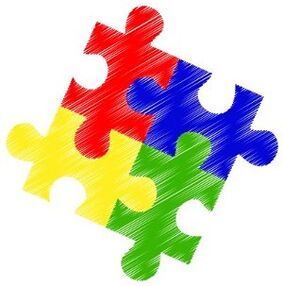
With the development of osteochondrosis and complicationsYou have to resort to drugs more and more, increasing the dosage.Due to side effects of the drug, this leads to high financial costs and further deterioration of health.
Usually, using an orthopedic corset of varying degrees of stiffness to fix a spine or friend, can supplement medication.
























